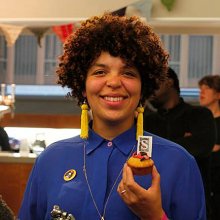
Jazlyn Pinckney Inclusion Producer
on Tue 7 Dec 2021Inclusion guided by Principles
Posted on Tue 7 Dec 2021
Former Watershed Inclusion Producer*, Jazlyn Pinckney reflects on the importance of creating shared principles when working collaboratively on data led inclusion.
Data led inclusion has been an approach that I have talked about before in my previous blog. A way to make sure we are committing to readdressing balance, but more than that, it’s a way for us to build a dialog between us and communities. Asking people to engage in a process that supports everyone to be counted for the cause of equitable change.
When I started my role with Watershed – and began thinking about data led inclusion – I was thinking about the kind of work I had done before. Working with pre-existing demographic survey forms. The ones that probably haven’t been updated for a minute. The ones that always bring me out in a cold sweat as I agonise over which one box describes me? The ones that had slightly different GDPR settings and varying wording on the questions so that aggregating them was nearly impossible.
Just so happened I was in good company. Tony Bhajam, Layla Barron and Luke Emery were also thinking about how functional inherited surveys were.
Casual conversations turned into something more, and the four of us began to meet regularly to unpick, examine and reimagine what a data led inclusion process could be.
I tell you this background so that you can understand that there was a moment in which we all thought independently that this would be an easy(ish) first step…and the real inclusion work would happen once we had some data to let us know who our projects already support, and who is missing?
Well, this ‘first step’ took us down a rabbit hole of 4 months of work. Where each question prompted 10 more. A place where we had to understand the emotional work it takes to ask and receive personal data. We all really understood the amount of care and diligence we needed to build within this process, but also needed to ensure that the data was useful! Why are we asking for all this information, how will it actually feed into change?
Luckily, as the Inclusion Data working group (or as we are really trying to make a ‘thing’; The Data Alliance) we were committed to the detailed work.
We broke this down as the following steps:
-
What are we asking?
Demographic Data surveys or Equal Opportunity forms are usually taken from funding requirements, or government initiatives. The language used in these types of documents isn’t agile enough to keep up with the conversations happening around inclusive language. We committed ourselves to digging deep into researching better, more inclusive language. We celebrated the work already being done by Inc Arts’ #BAMEOver, Scope, Stonewall and UNLIMITED and used that guidance to rewrite how we asked our questions.
-
Why are we asking it?
In an age where you are asked to give your details and data out all the time, we needed to be sure we really understood why we are asking theses specific questions? What will we actually do with this insight once we have it, and how can we communicate that with everyone so that we bring people with us and work transparently towards change?
-
What haven’t we been asking?
And lastly, there is a huge short falling with JUST asking about demographic data. Just because you can count who is there, doesn’t mean you are getting any knowledge on what it feels like to be there! We were massively inspired by Aubrey Blanche and her work with Atlassian and Culture Amp to include questions that gave us insight into how much of a sense of belonging people have working with Watershed.
As we got deeper into the heart of this work, the scope of how big, how detailed, how sensitive this work is became nearly overwhelming. There was a real tension that we just weren’t giving ourselves enough time, which meant a reoccurring theme of pushing back deadlines of when our new and improved survey would go live. And we found it hard to express why it was taking so long. We were so deeply entwined with the work, that sharing with the wider team was hard; we were rewriting a process, inspired by lots of amazing forward-thinking work – but there was no playbook all ready for us to use. We had to write the new approach ourselves. In this sticky moment we needed something to help galvanise us, get us back to the same page. Even though the end product might not be ready, we needed something to translate and talk about our process with the wider team.
And so, the Inclusion Principles where born; out of necessity to talk about why we are doing this work and what data led inclusion really stands for. We spent an afternoon freely and opening talking about what really mattered to us and this work.
I leave you with these guiding principles below, what they mean, and our inspiration.
They have turned into the cornerstone of this work and I’m grateful to share them.
Benchmarks aren't enough
We aren’t motivated to match population benchmark numbers; that isn’t setting our sights high enough. We are motivated by data led improvements in inclusion.
That looks like a better balance of lived experiences in our staff teams which will lead to greater diversity in communities who want to work and participate with us
We use staff data to interrogate our company culture, eg, wage disparity, staff retention and promotions, talent development and a sense of belonging
Follow up research:
Article: Practical ways to tackle diversity without positive action
Extract from article:
‘Being able to outline the company vision and approach clearly to employees is critical in encouraging buy-in. Be clear about why this is a strategic priority for the company and not just a brand exercise.
It may not just be about ethnicity, but could include broadening the diversity of skills, experience, culture and background in order to harness the best mix for the company or specific teams.’
Article: Why are we still getting inclusion wrong?
Extract from article:
‘Simply adopting a diversity initiative because it has gained popularity or has worked for a competitor doesn’t mean it will have the same impact in your organisation. “Take diverse interview panels,” says Douglas. “In most organisations, women and BAME staff are more junior. They may well be more junior than the hiring manager, which creates a certain power dynamic. They can tell that manager why they think their candidate is the best person for the role, but [the manager] will still pick their preferred candidate because they’re the most senior person in the room. They’re not examining why their interview panels aren’t working; they’re ‘solutioneering’.”
Intersectionality at the centre
We believe that the strength of inclusion comes when we see us all as full and intersectional people. Systems need to change, not people. We work towards a company culture that everyone can bring their full selves to, and we invest in systems that correct for historic inequity and unconscious bias.
Learning from the lessons of the past, when we silo our efforts into specific protected characteristics (for example, increasing the number of new employees from communities who have experienced racism) it can undermine the professional expertise of the new hire, effect the cohesion of staff teams and doesn’t allow for more subtle and nuanced ways of self-expression.
‘Tokenism and affirmative action don’t feel good and can promote or persist coloniality/benevolent power structures’
Follow up research:
Video: Rethinking Diversity | Aubrey Blanche, Atlassian (watch from 9.11)
Summary of video:
‘We've realized that in order to continue making progress, we've got to go beyond our sometimes-limited associations with “diversity.” It's not only about how many people of a specific demographic are represented at the company level. It's about balancing various perspectives--which we know come from our identities and life experiences--across teams, at all levels of the organization. And it’s about how people feel when they come to work
Balance allows us to consider the experiences of people who are often left out of the “diversity” conversation: people with disabilities, Indigenous people, caregivers, autistic people, those with intersectional or liminal identities, and many others. We believe that helps everyone feel like they have a stake in the conversation and helps create greater incentives for everyone and support each of their teammates.’
This work takes time
Investing in inclusion means investing in the time to do things properly. That means often balancing our urgency for change with time to research what has come before us, understand and unpick what systems hold us in place and think creatively about strategies that will build a road towards intersectional equity.
Placing high value on our fact finding, listening and thinking with communities, ideation and systems set-ups means we can relabel these slower moments as action.
We want to invest in setting up culture change that lasts, whilst still understanding that language and approaches must stay malleable and adaptive. We are readying our organisation for diversity, not the other way around
Follow up research:
Article: Tricia Hersey’s The Nap Ministry
Extract from article:
‘Let slow research be a part of your deprogramming and healing. You will not get free by simply reading memes on social media and attempting to quickly engage via the fast paced scroll life. You will have to stop. You will have to dismantle your own unique cultural history in order to heal your own collective and individual traumas. You will have to do real work to change.’
Build trust and share value
By committing to data led inclusion, we are asking a lot of our community, especially those who are underrepresented. We have a duty of care to understand the fears, frustrations, worries, and complexity involved in asking people to declare information about their protected characteristics.
Moreover, we understand the care needed to think about how we use this data to serve, and support those in less dominant and secure positions.
Asking for, and holding others’ personal data is a privilege, we are committed to sharing openly our intentions for data led inclusion, working actively to ensure language and question-setting are designed with care and respect and we are committed to build trust with our communities, bringing them with us in our findings.
Follow up Research:
Approach: Consentful Tech
Overview of approach:
‘The Consentful Tech Project’s definition of good digital consent is Freely Given, Reversible, Informed, Enthusiastic and Specific.’
*Jazlyn worked, as part of Watershed’s Inclusion Data Working Group, on the development of our approach to data-led inclusion. She has since moved to a new role as Head of Workforce Development at One Dance UK where she continues to work in partnership with Watershed on the ongoing development of the approach.

